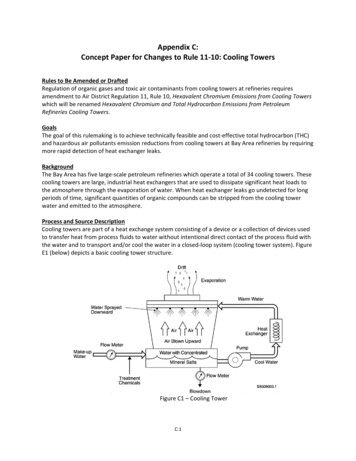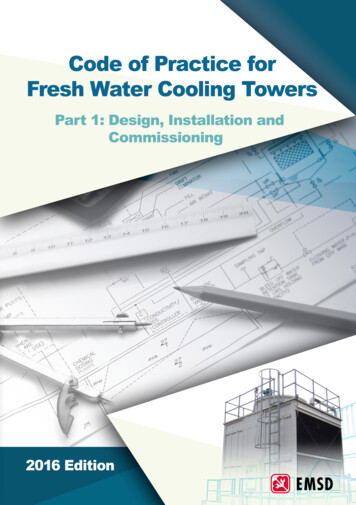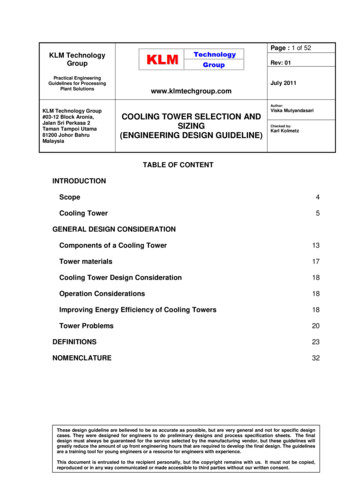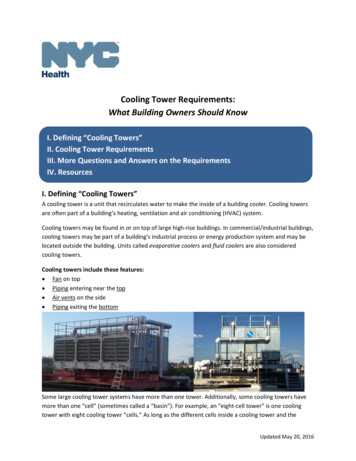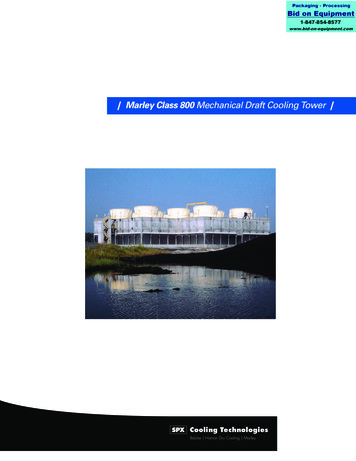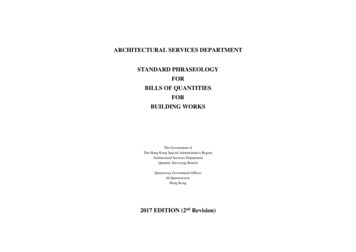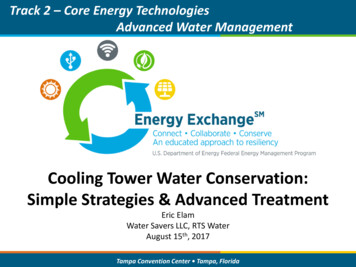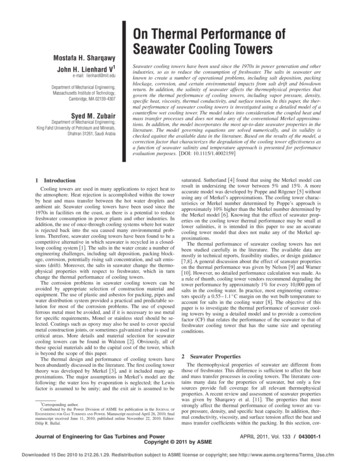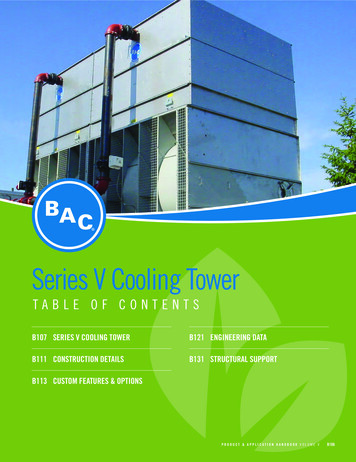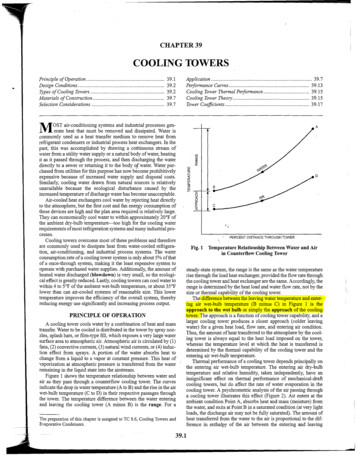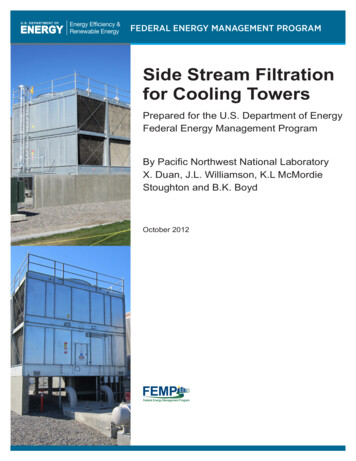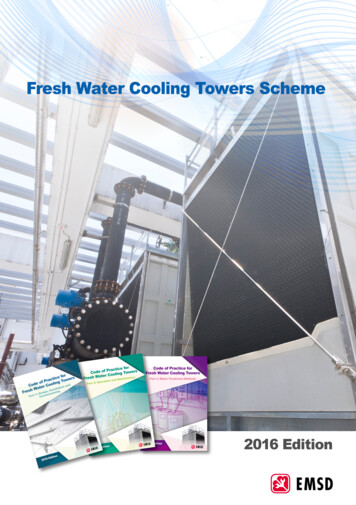
Transcription
Fresh Water Cooling Towers SchemeFresh Water Cooling Towers Scheme2016 EDITION(DEC 2016)Electrical and Mechanical Services DepartmentThe Government of the Hong Kong Special Administrative Region2016 Editioni
Fresh Water Cooling Towers SchemeContentsDefinitionsPageiiiPart 1 Introduction1.Background2.The Scheme2.1 Aim2.2 Conditions of Participation2.3 Conditions for Suspension or Cessation2.4 Reviews2.5 Designated Areas11333444Part 2 Participation Procedures and Guidance3.Statutory Requirements4.Codes of Practice5.Basic Requirements for Registration under the Scheme6.Information required for Application7.Records Keeping during Operation7.1 Records on Operational Conditions7.2 Annual Audit Report7.3 Notification Required during Operation8.Waterworks9.Building Works10. Sewage Services Charge11. Water Pollution Control12. Air Pollution Control13. Noise Control14. Nuisance Control15. Occupational Safety and Health16. Buildings Energy Efficiency55567881010111314141515151616Part 3 Information for Application and Enquiry17. Forms18. Process Chart19. Enquiries171717182016 Editionii
Fresh Water Cooling Towers SchemeDefinitionsIn this brochure of the Fresh Water Cooling Towers Scheme (the Scheme Brochure), unlessthe context otherwise specifies,“a cooling tower” means any device for lowering the temperature of water by evaporativecooling in which ambient air is in contact with falling water, thereby exchanging heat;“drift” means water lost from the cooling tower as liquid droplets or aerosols entrained inthe exhaust air, excluding condensation.2016 Editioniii
Fresh Water Cooling Towers SchemePart 1: Introduction1.Background1.1 The Preliminary Phase Consultancy Study on Wider Use of Water-cooled AirConditioning Systems (WACS) in Hong Kong was completed in mid-1999.The study has established that WACS has greater environmental, economicand financial benefits than Air-cooled Air Conditioning Systems (AACS).Subsequently, a territory-wide implementation study was completed in mid2003 for facilitating a full-scale implementation of WACS. The implementationstudy examined and identified areas suitable for wider use of WACS and alsoexamined in detail the financial, regulatory, land administration, infrastructural,environmental and health issues, including the prevention of Legionnaires’disease.1.2 An inter-departmental working group (hereinafter referred to as “the WorkingGroup”) was set up on 1 June 2000 to launch a pilot scheme for wider use offresh water in evaporative cooling towers in energy-efficient air conditioningsystems (the Pilot Scheme) in designated areas where existing water suppliesand sewerage network would be adequate to meet the additional demand.Although both sea water and fresh water can be used as the condensing coolingmedia, the Pilot Scheme was only applicable to fresh water evaporative coolingafter considering the source and capacity of existing water supply networks.The Working Group currently comprises members from two policy bureaux andseven government departments:2016 Edition Development Bureau (DEVB) Environment Bureau (ENB) Buildings Department (BD) Drainage Services Department (DSD) Electrical and Mechanical Services Department (EMSD) Department of Health (DH) Lands Department (LandsD) Planning Department (PlanD) Water Supplies Department (WSD)1
Fresh Water Cooling Towers Scheme1.3 The interim reviews in 2005 and 2007 of the Pilot Scheme have revealed theScheme has been a promising way to ascertain the energy efficiency in airconditioning systems for new and existing non-domestic buildings withoutposing adverse impact on the existing water supply and sewerage infrastructures.As a result, with support of the policy bureaux concerned, the Pilot Scheme hasoperated as a standing scheme from 1 June 2008, and renamed as “Scheme forWider Use of Fresh Water in Evaporative Cooling Towers for Energy-efficient AirConditioning Systems” or, simply, as “Fresh Water Cooling Towers Scheme” or“FWCT Scheme” (hereinafter referred to as “the Scheme”). The regulatory andinstitutional framework of the Scheme basically remained unchanged exceptsome updates in the operational and validation requirements.1.4 A further review was conducted in 2010 to streamline the applicationprocedures and update the requirements for joining the Scheme.1.5 To cope with the latest requirements of relevant regulations and internationalstandards, and be in line with current good trade practice for using fresh watercooling towers, a Task Force was set up in October 2015 to review the SchemeBrochure (2010 Edition) and the associated Code of Practice for Water-cooled AirConditioning Systems: Parts 1, 2 & 3 (2006 Edition). The Task Force comprisesmembers from eight government departments, three professional institutionsand three trades unions: Architectural Services Department (ArchSD) Buildings Department (BD) Drainage Services Department (DSD) Electrical and Mechanical Services Department (EMSD) Environmental Protection Department (EPD) Department of Health (DH) Housing Department (HD) Water Supplies Department (WSD) The Association of Consulting Engineers of Hong Kong (ACEHK) ASHRAE (Hong Kong Chapter) (ASHRAE-HKC) Building Services Operation and Maintenance Executives Society (BSOMES) The Chartered Institution of Building Services Engineers (Hong KongBranch) (CIBSE-HKB) The Hong Kong Air-conditioning & Refrigeration Association (HKACRA) The Hong Kong Institution of Engineers (HKIE)2016 Edition2
Fresh Water Cooling Towers Scheme1.6 The review has further updated some requirements stipulated in the SchemeBrochure (2010 Edition) and the Code of Practice for Water-cooled AirConditioning Systems: Parts 1, 2 & 3 (2006 Edition). The titles of “Fresh WaterCooling Towers Scheme for Air Conditioning Systems” (2010 Edition) and “Codeof Practice for Water-cooled Air Conditioning Systems: Parts 1, 2 & 3” (2006Edition) have been renamed as “Fresh Water Cooling Towers Scheme” (2016Edition) and “Code of Practice for Fresh Water Cooling Towers: Parts 1, 2 &3”(2016 Edition) respectively.2.The Scheme2.1 AimThe Scheme aims to:(a) promote energy-efficient water-cooled air conditioning systems;(b) monitor the additional water demand;(c) monitor the quantity and quality of bleed-off effluent discharge from thesystems;(d) monitor the health and environmental effects arising from the systems; and(e) compile data for formulating and updating plans to promote water-cooled airconditioning systems in Hong Kong.2.2Conditions of Participation2.2.1 This scheme applies to all non-domestic buildings1 and other buildings2 wherethe use of fresh water for evaporative cooling is supplied for non-domestic usagewithin the designated areas (see Section 2.5 below). All property developers,landlords, property management agents, designers and system operators arewelcome to apply for the use of fresh water for fresh water cooling towers intheir buildings within the designated areas. Applications for buildings not withinthe designated areas are also welcomed and will be considered on a case-bycase basis in consultation with the WSD on the adequacy of fresh water supply.All applications should be submitted together with the required information asstipulated in Section 6 to the authorities concerned.1 T he definition of non-domestic buildings that include both new and existing buildings should be referred to theBuildings Ordinance (Cap. 123).2 O ther buildings include composite buildings, a detached (or stand-alone) clubhouse building ancillary to a residentialdevelopment and “hotel-like” service apartment.2016 Edition3
Fresh Water Cooling Towers Scheme2.2.2 All participants should make sure that all applications should comply with allrelevant statutory regulations as well as basic requirements as laid down in Part2 for joining the Scheme. Besides, the participants are recommended to adoptthe best practices related to the design, operation and maintenance of coolingtowers as per the guidelines and recommendations given in relevant codes ofpractices.2.2.3 All these requirements are set to achieve better energy efficiency, to protect theenvironment and to safeguard the public health and safety while using freshwater for evaporative cooling.2.3Conditions for Suspension or Cessation2.3.1 Though the Scheme is aimed to be a standing scheme, it can still be suspendedor ceased upon obtaining the endorsement from the Working Group under thefollowing conditions:(a) Water rationing is implemented in the territory; or(b) An outbreak of Legionnaires’ disease in the territory; or(c) Water resources are anticipated to be inadequate or water supplyinfrastructure cannot cope with the demand by fresh water cooling towersystems.2.3.2 If the Scheme is suspended or ceased under the above conditions, all newapplications will not be processed. The water supply to the registered coolingtowers installation will be subject to regulation by the Water Authority (WA).The trade will normally be notified not less than six (6) months in advance,unless the suspension or cessation should be executed immediately due to somesevere situations.2.4ReviewsThe conditions and requirements in the Scheme Brochure for registration of cooling towersunder the Scheme will be subject to review by the Working Group so as to facilitate thepromotion of the use of water-cooled air conditioning systems in Hong Kong.2.5Designated AreasThe designated areas for application for joining the Scheme are delineated in the latestlocation plans which can be downloaded at EMSD’s website: http://www.emsd.gov.hk.2016 Edition4
Fresh Water Cooling Towers SchemePart 2: Participation Procedures and GuidanceThis part describes the statutory requirements, information required and processesinvolved with various government departments in the application for joining the FWCTScheme.3.Statutory Requirements3.1 In general, the applicants should ensure that their cooling towers comply with,among others, the following Ordinances, Objectives, and Technical Memoranda: Waterworks Ordinance (WWO) (Cap. 102) Buildings Ordinance (BO) (Cap. 123) Sewage Services Ordinance (SSO) (Cap. 463) Water Pollution Control Ordinance (WPCO) (Cap. 358) Air Pollution Control Ordinance (APCO) (Cap. 311) Noise Control Ordinance (NCO) (Cap. 400) Occupational Safety and Health Ordinance (OSHO) (Cap. 509) Public Health and Municipal Services Ordinance (PHMSO) (Cap. 132) Buildings Energy Efficiency Ordinance (BEEO) (Cap. 610) Technical Memorandum on Standards for Effluent Discharged intoDrainage and Sewerage System, Inland and Coastal Waters Technical Memorandum for the Assessment of Noise from Places otherthan Domestic Premises, Public Places or Construction Sites WSD’s Water Quality Objectives of Sea Water for Flushing Supply (atDistribution)3.2 Applicants are advised to check other relevant statutory requirements and seekprofessional advice from a Licensed Plumber (LP), an Authorized Person (AP)and a Registered Professional Engineer (RPE) of Building Services or Mechanicaldiscipline when they have queries in the procedures and the standard of worksrequired.4.Codes of Practice4.1 Besides the above statutory requirements, the participants of the Schemeare required to adopt the best practices related to the design, operation andmaintenance of a cooling tower as per guidelines and recommendations given inthe latest edition of the following codes of practice:2016 Edition5
Fresh Water Cooling Towers Scheme5.(a)Code of Practice for Prevention of Legionnaires’ Disease (CoP(PLD))(b)Code of Practice for Fresh Water Cooling Towers (CoP(FWCT)): Parts 1-3Basic Requirements for Registration under the Scheme5.1 For registration of cooling tower installation under the Scheme, the applicationsshould meet the following five basic requirements of design and installation fortheir cooling towers:(a) The exhaust of cooling tower should be distant from:(i) the surrounding air intakes, exhaust, operable windows andpublic accessible area, other than those stated in (ii) below, with aminimum of 7.5m horizontal separation in general; and(ii) for the cooling tower within 7.5m from its own building façadeboundary, air intakes and exhausts and operable windows onits vertical building façade by a minimum of 7.5m below or 20mabove.Other separation requirements should be referred to CoP(FWCT) Part 1.(b) A cooling tower should be provided with effective drift eliminators(with drift emission not more than 0.005% of maximum design watercirculation rate) that minimise the formation and release of drift3.(c) A cooling tower should be provided with effective water treatmentequipment and bleed-off device to control bacterial growth. Bleed-offwater from a cooling tower should be discharged to the flushing tank(via a break tank if applicable) and reused for flushing purpose4 as far aspracticable.(d) Dead legs should be minimised to avoid stagnant water as far aspracticable in the cooling water circulation pipeworks for the coolingtower, and, where unavoidable, purge valves should be provided to thedead legs for regular draining.(e) A cooling tower should be provided with adequate and safe access toallow for the maintenance, inspection and water sampling required underthe Scheme.5.2 Participants should also make sure the cooling towers meet other requirementsas stipulated in CoP (FWCT), including the following:(a) Cooling tower should be thoroughly cleaned, desludged and disinfectedat least once every six (6) months5.3 Ref. CoP (FWCT) Pt. 1 – s.3.64 This arrangement is to minimise the burden of additional effluent to the sewage systems.5 Ref. CoP (FWCT) Pt. 2 – s. 3.4.12016 Edition6
Fresh Water Cooling Towers Scheme(b) A cooling tower should be maintained to ensure that the cooling towerhas a total legionella count that is below 10 cfu/ml and a heterotrophiccolony count that is below 100 000 cfu/ml6. The owners of the coolingtower should conduct water sampling tests for the cooling tower at leastonce every three (3) months for total legionella count; and at least once amonth for heterotrophic colony count.(c) Risk management plan7 (or water safety plan8) should be provided fora cooling tower system to be installed at such facilities as stipulated inSection 7 of the CoP(FWCT): Part 1.6.Information Required for Application6.1 The applicants should appoint a Registered Professional Engineer of BuildingServices or Mechanical discipline (hereinafter referred to as the RPE) wellin advance for advice on the proper design, installation, operation andmaintenance of cooling tower.6.2 At the early stage of cooling tower installation design, applicants should provideinitial information as required in the application form (Form EMSD EE CT1A)for preliminary assessment and acceptance in principle of their application.Applicants should submit the plumbing proposal and the Form WWO 542 tothe Water Authority. For buildings in non-designated area, applicants shouldsubmit Form EMSD EE CT1A to the EMSD who subsequently consult the WSDon adequacy of fresh water supply.6.3 Before cooling tower installation works are commenced on site, applicantsshould submit Form EMSD EE CT1B with installation details in Form EMSD EECT4 to EMSD. After receiving acceptance of plumbing proposal from the WA,applicants should submit Form WWO46 (Part I and II) to the WA for approval forthe plumbing works to be commenced for cooling tower installation.6.4 After cooling tower installation works are completed, applicants should submitForm EMSD EE CT2B (or Form EMSD EE CT2A, for phased completion ofcooling tower installation) with site inspection report and Form EMSD EE CT3for assessment. Applicants should submit WWO46(Part IV) to the WA forinspection of plumbing work.6 Ref. CoP (FWCT) Pt. 2 – s. 2.5.37 Ref. CoP (FWCT) Pt. 1 – s. 7.28 Ref. s 4.1 of CoP(PLD), 2016)2016 Edition7
Fresh Water Cooling Towers Scheme6.5 The approval granted for each stage of submission by means of Forms EMSD EECT1A or CT1B has a validity of five (5) years, counting from the approval date ofeach application. Applicants should submit Form EMSD EE CT1B (or Form EMSDEE CT2B) within five (5) years after the approval date of Form EMSD EE CT1A (orForm EMSD EE CT1B). If the applicants cannot proceed with their applicationsto the next application stage within the validity period, the applications areconsidered invalid.6.6 All forms should be signed by a Registered Professional Engineer of BuildingServices or Mechanical discipline to certify that the cooling tower installation hasbeen designed and installed in accordance with the requirements stipulated inthe Scheme Brochure and Code of Practice for Fresh Water Cooling Towers.6.7 If direct discharge of bleed-off water to public sewerage system is required,applicants should apply for discharge licence from EPD. Applicants shouldinclude the rate of total effluent and peak daily bleed-off volume in theirsubmissions of drainage plan to BD. Application procedures and detailedinformation are stipulated in Section 11 below and process chart for applicationfor direct discharge can be downloaded at EMSD’s website: http://www.emsd.gov.hk.6.8 In case a cooling tower is proposed to be installed at an existing compositebuilding (residential & commercial) or existing domestic building, the ownerof a cooling tower should consult relevant residents’ associations or alike, ifany, such as Owners’ Corporations or Incorporated Owners, ManagementCommittees or Owners’ Committees, Mutual Aid Committees or alike, aboutthe proposed location of a cooling tower at the initial project design stage. Fornew residential development, when the cooling towers proposed to be installedare likely to materially affect the enjoyment of the residential property, ownersof cooling towers of the development (e.g. the developer or vendor) may needto notify the future buyers during the sale of the residential properties by anypossible means such as including the proposed location of cooling towers inthe sales brochure as set out in the Residential Properties (First-hand Sales)Ordinance.7.Record Keeping during Operation7.1 Records on Operational Conditions wners of cooling towers installation should monitor and properly operate theirOinstallations, and maintain their condition and performance. They are required to keeprecords on the following information (via Form EMSD EE CT3) on a monthly basis untilthe cooling towers are dismantled and put out of service. The owners of cooling towersshould provide such records for inspection as requested by the EMSD.2016 Edition8
Fresh Water Cooling Towers Scheme(a) Condition of each cooling tower shell and its supporting framework;(b) Daily operation time(s) and monthly sampling date;(c) Monthly energy consumption for all water-side equipment of the cooling towersystem(s);(d) Monthly total water consumption volume of the system(s);(e) Monthly total effluent discharge volume of the system(s);(f) Quarterly sampling and testing of bleed-off water from the cooling towerinstallation by laboratory accredited under Hong Kong Laboratory AccreditationScheme using accredited methods wherever applicable in respect of thefollowing parameters9: Colour (H.U.); Turbidity (N.T.U.); Threshold Odour No. (T.O.N.); Ammoniacal Nitrogen; Suspended Solids (SS); Dissolved Oxygen (DO); 5-Day Biochemical Oxygen Demand (BOD5); Synthetic Detergents; Residual biocides/inhibitors concentration; and E. Coli/100 mL (ECL).(g) Monthly sampling and testing of the cooling water of the cooling towerinstallation in respect of the following parameters: Suspended Solids (SS); Total dissolved solids (TDS); Conductivity; Calcium hardness; pH; Temperature; Chemical Oxygen Demand (COD); Residual Cl/ Oxidation Reduction Potential (ORP); 5-Day Biochemical Oxygen Demand (BOD5); Residual biocide(s); and Residual corrosion/scale inhibiting chemical(s).9 T he parameters, other than residual biocides/inhibitors, are monitored for meeting WSD’s Water Quality Objectivesof Sea Water for Flushing Supply (at Distribution).2016 Edition9
Fresh Water Cooling Towers Scheme(h) Monthly sampling and testing of the cooling water of the cooling towerinstallation for heterotrophic colony count;(i) Quarterly sampling and testing (or whenever required by the approving authoritysuch as after commissioning or major alterations) of cooling water of the coolingtower installation for total legionella count (comprising categories of legionellapneumophila serogroup 1, legionella pneumophila serogroup 2 to 14, andother species of legionella) for validation of the effectiveness of the preventivemeasures against the growth of legionella; and(j) Maintenance records of each cooling tower as stipulated in the current versionof Section 7 of the Code of Practice for Prevention of Legionnaires’ Disease andAppendix 2E of Part 2 of the Code of Practice for Fresh Water Cooling Towers.7.2Annual Audit ReportT he owners of cooling towers should engage an independent and competent auditor toconduct an annual audit for their cooling towers system in accordance with Section 4.3of Part 2 of the Code of Practice for Fresh Water Cooling Towers. They should submitthe annual audit report to EMSD every year during the service life of the cooling towersystem.7.3Notification Required during Operation7.3.1 Alterations of Cooling Tower Installation(a) Minor alterations of a cooling tower For minor alterations of a cooling tower, such as a change of watertreatment system, the owners of the cooling tower should notify theEMSD with submission of Form EMSD EE CT4 as soon as possible.(b)Replacement of a cooling tower For works involving replacement of an existing cooling tower at thesame location, Form EMSD EE CT1B and Form EMSD EE CT4 should besubmitted to the EMSD for approval before the replacement works ofcooling tower are commenced.(c) Major alterations of a cooling tower installationFor works involving following major alterations:(i) Change in number of cooling towers;(ii) Change in a cooling tower location; or(iii) Any factors affecting separation between buildings’ accessible areas,openings/louvers and cooling tower intakes/exhausts.F orm EMSD EE CT1A should be submitted to the EMSD for approval before theworks are commenced.2016 Edition10
Fresh Water Cooling Towers Scheme7.3.2 Change of Ownership of Cooling Tower hen transfer of installation ownership occurs, the existing owner and newWowner of approved cooling tower installation should complete the notificationForm EMSD EE CT5 and submit to EMSD for update of records.7.3.3De-registration(a) The owner of cooling tower is required to notify the EMSD and WSD inwriting within 30 days after removing or permanently discontinuing useof cooling tower.(b) Cooling tower will be de-registered from the Scheme if the cooling towersystem is no longer found to be complied with the requirements underthe Scheme.8.Waterworks8.1 Prior to any submission of proposal for new plumbing installations or alterationto existing plumbing installations for main water supply to a cooling tower, theapplicant should obtain from the WA such information which is relevant to thedesign of the plumbing works. The applicant should submit to the WA theplumbing proposal and consumership undertaking by Form WWO 542.8.2 Upon receipt of the plumbing proposal to use main water for a cooling tower,the WA will reply to the applicant in writing within 20 working days informinghim whether such proposal is acceptable or not. Under normal circumstance,separate metering, thus separate water account, for this kind of supply isrequired. The applicant is reminded that a break tank for retaining bleed-offwater from the cooling tower for reuse in internal flushing is normally required.The break tank shall be designed and constructed similar to that as stated inClause 8.14 of the Hong Kong Waterworks Standard Requirements for PlumbingInstallation in Buildings. Any subsequent alteration, revision and modification ofthe approved proposal should be submitted to the WA for approval.8.3 Prior to commencement of the plumbing works for main water supply of acooling tower shown on any approved plumbing proposal, the applicant shallsubmit to the WA by Licensed Plumber Form WWO 46 (Parts I and II). The WAwill return Form WWO 46 (Part III) to the applicant for whether the permissionto commence plumbing works is granted. The approval of providing meteredwater supply will not confer any legal implication on structural status of the acooling tower nor carry any effect of precluding action being taken in respectof the structure by another authority. As the building works for the a coolingtower is under the jurisdiction of the Building Authority, it is premises owners’responsibility to obtain relevant consent from the Building Authority for theseworks where applicable. Failure to do so may result in removal of these coolingtower by the Building Authority.2016 Edition11
Fresh Water Cooling Towers Scheme8.4 Upon completion of the cooling tower installation, the owner should submitForm EMSD EE CT2B together with a site inspection report and Form EMSD EECT3 completed by the RPE to EMSD. EMSD will notify the applicant for whetherthe cooling tower installation is accepted under this Scheme. The applicant andthe licensed plumber should apply to the WA for inspection of plumbing worksby Form WWO 46 (Part IV). The WA will notify the applicant by Form WWO46 (Part V) for whether the plumbing works up to make-up tank are completedsatisfactorily. The applicant should ensure that all works other than waterworksare completed satisfactorily and acceptable to EMSD and the Building Authority.In case phased completion for the cooling tower installation is required, theapplicant should submit Form EMSD EE CT2A together with a site inspectionreport and Form EMSD EE CT3 completed by an RPE to EMSD. EMSD will notifythe applicant whether the phased completion of the cooling tower installationis accepted under this Scheme. The applicant should request the WA for watersupply for phased completion. The WA will arrange concessionary water supplyto the cooling tower installation under phased completion provided that theplumbing works concerned are completed satisfactorily. The applicant shouldinform EMSD when the whole installation is completed.8.5 Temporary Water Supply for Testing and Commissioning8.5.1 If there is no appropriate water source available for testing and commissioningof the cooling tower, applicants may submit Form EMSD EE CT3 to EMSD withinsix (6) months after Form EMSD EE CT2B (or Form EMSD EE CT2A) is acceptedby EMSD. The WA will provide temporary water supply for carrying out thetesting and commissioning within the specified period for the following twoconditions:(i) submissions of Form EMSD EE CT2B (or Form EMSD EE CT2A) is acceptedby the EMSD; and(ii) inside service and water testing results in relation to the cooling towerssystem are in compliance with the latest standards and requirements asrequired by the WA.I f the applicants fail to submit the Form EMSD EE CT3 to the EMSD within thespecified period, the WA will consider disconnection of the temporary watersupply to the cooling tower.8.5.2 After obtaining the EMSD’s acceptance of Form EMSD EE CT3 and if changein water consumership is involved, applicants should report the reading of thewater meter together with submission of Form WWO 1145 to the WSD. Ifthere is no change in water consumership, applicants should formally notify theWSD by writing to report the reading of water meter with date stamped photocertifying the reading of the water meter.2016 Edition12
Fresh Water Cooling Towers Scheme9.Building Works9.1 Any person who intends to carry out building works such as supportingstructures for a cooling tower, and water tanks for air conditioning systems isrequired under the Buildings Ordinance (BO) to appoint an Authorized Person,and where necessary a Registered Structural Engineer, to prepare and submitplans for the approval of Building Authority (BA) and apply for consent tocommence building works before the commencement of the works. He is alsorequired to appoint a registered contractor to carry out the building works.Upon completion of the building works, the Authorized Person is required tocertify that the building works have been carried out in accordance with theapproved building plans.9.2 It is strongly recommended that professional advice of an Authorized Person/Registered Structural Engineer should be sought well in advance. The BAmaintains separate registers of Authorized Persons, Registered StructuralEngineers and registered contractors including Registered General BuildingContractors and Registered Minor Works Contractors. The registers are availableat the website of Buildings Department: http://www.bd.gov.hk.9.3 Building works designated as minor works may be carried out without obtainingprior approval and consent from the BA, but should comply with the simplifiedrequirements of the Minor Works Control System, including the appointmentof prescribed building professionals and/or prescribed registered contractors.Whether the building works are minor works, they still have to comply with thebuilding standards such as fire safety and structural safety standards stipulatedin the Building Regulations. For the details of the Minor Works ControlSystem, please refer to “General Guidelines on Minor Works Control System”and “Technical Guidelines on Minor Works Control System” published by theBuildings Department.9.4 The BA may take enforcement action by serving orders on the owners forunauthorised building works and/or prosecution action against offenders.9.5 Under the BO, any person, who carried out building works (except minor works)without the prior approval and consent of the BA, commits an
Fresh Water Cooling Towers Scheme 1.6 The review has further updated some requirements stipulated in the Scheme Brochure (2010 Edition) and the Code of Practice for Water-cooled Air Conditioning Systems: Parts 1, 2 & 3 (2006 Edition). The titles of "Fresh Water Cooling Towers Scheme for Air Conditioning Systems" (2010 Edition) and "Code
